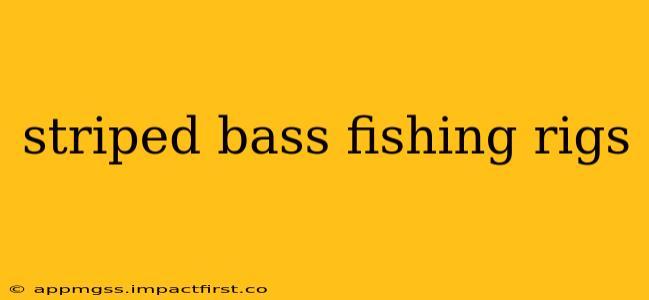Striped bass, or stripers, are highly sought-after game fish known for their power and fight. Landing one requires more than just a rod and reel; the right fishing rig is crucial for success. This comprehensive guide explores various striped bass fishing rigs, helping you choose the best setup for different situations and techniques. We'll cover everything from simple rigs for beginners to more advanced setups for experienced anglers.
What are the Best Rigs for Striped Bass Fishing?
The "best" rig depends heavily on your fishing location, the time of year, and the techniques you employ. However, some rigs consistently prove their worth for targeting striped bass. These include:
-
Fishing with Live Bait: This often involves using rigs designed to keep the bait lively and appealing to stripers. Common choices include a simple fish finder rig (a small weight above a swivel and hook) or a Carolina rig (a weight on the main line with a leader and hook). These are effective for bottom-feeding stripers.
-
Fishing with Lures: A vast array of lures works for stripers. The rig choice here often focuses on presentation. Popular options include:
-
Jigging Rigs: These consist of a jig head (weighted hook) and a soft plastic lure or bucktail. Jigging involves vertically working the lure to entice strikes.
-
Spinnerbaits: These lures feature a spinning blade that creates flash and vibration, attracting stripers from a distance. They're often fished with a simple swivel and snap.
-
Plugs: These include poppers, crankbaits, and stickbaits. The rigging varies depending on the plug type but often involves a split ring and treble hook.
-
What Kind of Tackle Do I Need for Striped Bass Fishing?
Choosing the right tackle is just as crucial as selecting the right rig. Consider these factors:
-
Rod: A medium-heavy to heavy power rod with a fast action is ideal for handling the strong pulls of striped bass. The length should suit your fishing style and location.
-
Reel: A spinning or conventional reel with a high gear ratio is recommended for quickly retrieving lures and setting the hook firmly. The reel should have a strong drag system to manage the powerful runs of a striper.
-
Line: Braided line offers excellent sensitivity and strength. Monofilament or fluorocarbon leader material is often used to connect to the lure or bait, as it is less visible to fish. The line weight should match the rod and the size of the stripers you're targeting.
What is the Best Bait to Use for Striped Bass?
Striped bass are opportunistic feeders, and their diet varies depending on location and season. Popular bait choices include:
-
Live Bait: Live eels, bunker, herring, and menhaden are all excellent choices.
-
Artificial Lures: A wide range of soft plastics, jigs, and plugs successfully entice stripers. Experimentation is key to finding what works best in your area.
How Do I Choose the Right Weight for My Striped Bass Rig?
Weight selection depends on several factors including:
-
Water Depth: Deeper water requires heavier weights to get your bait or lure down to the strike zone.
-
Current: Strong currents need heavier weights to keep your offering in place.
-
Bait/Lure: The size and type of bait or lure influence weight selection. A larger, heavier lure may not require as much additional weight.
What are Some Popular Striped Bass Fishing Techniques?
Success often hinges on employing the right technique. Common approaches include:
-
Chunking: This involves casting chunks of baitfish into the water.
-
Jigging: Vertically working a jig to attract stripers.
-
Trolling: Dragging lures or bait behind a moving boat.
-
Casting: Casting lures or bait to targeted areas.
Conclusion
Mastering striped bass fishing involves understanding the nuances of different rigs, tackle selection, bait choice, and fishing techniques. Experimentation and adapting your approach based on conditions are crucial for consistent success. Remember to always check local regulations and practice responsible angling. Tight lines!
